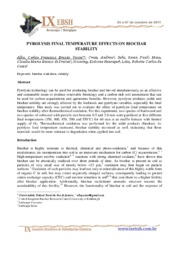Pyrolysis final temperature effects on biochar stability.
Pyrolysis final temperature effects on biochar stability.
Author(s): ALHO, C. F. B. V.; CROSS, A.; SOHI, S. P.; MAIA, C. M. B. de F.; NOVOTNY, E. H.; LELIS, R. C. da C.
Summary: Pyrolysis technology can be used for producing biochar and bio-oil simultaneously, as an effective and sustainable mean to produce renewable bioenergy and a carbon rich soil amendment that can be used for carbon sequestration and agronomic benefits. However, pyrolysis products yields and biochar stability are strongly affected by the feedstock and pyrolysis variables, especially the final temperature. This study was carried out to evaluate the effect of pyrolysis final temperature on biochar stability after thermochemical oxidation. For this experiment, two species of hardwood and two species of softwood with particle size between 0.5 and 2.0 mm were pyrolized at five different final temperatures (350, 400, 450, 500 and 550°C) for 60 min at an muffle furnace with limited supply of O2. Thermochemical oxidation was performed for the solid products (biochar). As pyrolysis final temperature increased, biochar stability increased as well, indicating that these materials would be more resistant to degradation when applied into soil.
Publication year: 2011
Types of publication: Paper in annals and proceedings
Unit: Embrapa Forestry
Observation
Some of Embrapa's publications are published as ePub files. To read them, use or download one of the following free software options to your computer or mobile device. Android: Google Play Books; IOS: iBooks; Windows and Linux: Calibre.
Access other publications
Access the Agricultural Research Database (BDPA) to consult Embrapa's full library collection and records.
Visit Embrapa Bookstore to purchase books and other publications sold by Embrapa.

